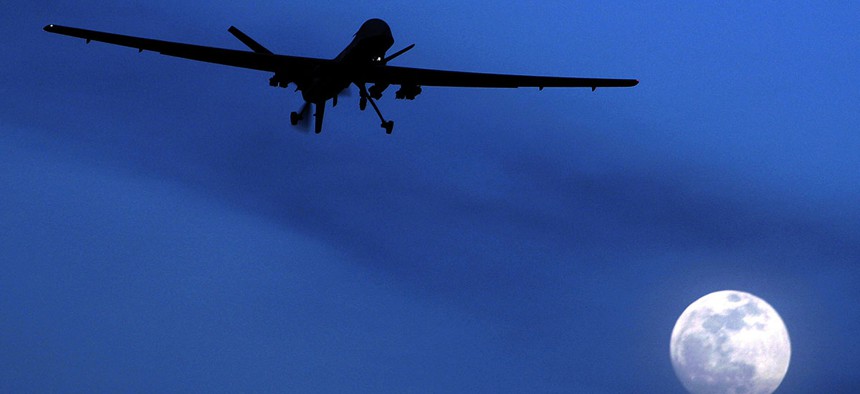Three-Star General Wants Artificial Intelligence in Every New Weapon System

Kirsty Wigglesworth/AP File Photo
The department's Project Maven uses machine learning to go through drone video feeds but that's just the beginning, Air Force Lt. Gen. Jack Shanahan said.
With artificial intelligence set to revolutionize how the military runs surveillance missions around the world, one top Defense Department official hopes to bring intelligent systems to the Pentagon’s efforts both on and off the battlefield.
As director of defense intelligence for warfighter support, Air Force Lt. Gen Jack Shanahan spearheaded Project Maven, a Pentagon initiative to rapidly turn drone surveillance footage into useful intelligence through machine learning. The tool is scheduled to launch by the end of the year.
The Pentagon has long used drones over the Middle East to inform the fight against groups like ISIS. Though drone and camera technology have advanced significantly, the back end looks much the same as it did decades ago, with analysts still spending countless hours manually scrolling through video for points of interest.
By automatically analyzing the videos for useful intelligence, Maven would take the burden off military personnel and free them up to more efficiently make decisions based on incoming information.
Shanahan believes the tool strikes at the heart of an issue facing both the Pentagon and federal government at-large: a lack of resources to sift through the incoming “avalanche of data.”
“It’s becoming more serious because we’re running out of people to throw at the problem,” Shanahan said Wednesday at NVIDIA’s GPU Technology Conference in Washington. The military needs better tools to help shift from the industrial to the information age, he said.
While most of the work in AI has happened in the research space, Shanahan stressed the need for concrete projects that put innovations to work in the real world. At the Pentagon, he sees opportunities for AI to not only assist data analysts at home, but also help fight enemies abroad directly on the battlefield.
“The Department of Defense should never buy another weapons system for the rest of its natural life without artificial intelligence baked into it,” Shanahan said.
The tool won’t be perfect when it’s first deployed in December, he said, but he and his team will continue to refine their algorithm through trial and error.
Shanahan believes the project marks the beginning of the Pentagon shifting toward a mindset of “prototype warfare” where the agency constantly improves its efforts through user engagement and feedback. He wants to further develop Maven for use in document analysis, wargaming and a number of other areas, and hopes the underlying technology will pave the way for further innovations throughout the military.
“Maven is designed to be that pilot project, that pathfinder, that spark that kindles the flame front for artificial intelligence across the rest of the department,” Shanahan said. “Everything we’re learning will be applicable to everything else that comes behind us.”
NEXT STORY: Can Computers Read? They're Learning To






